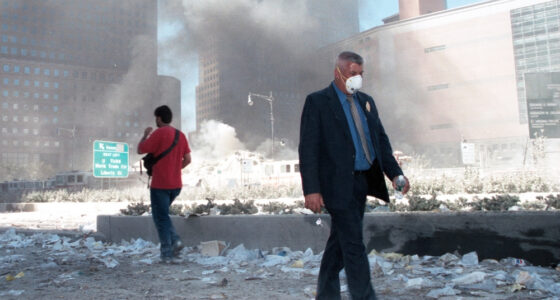One of the many concerns raised following the 9/11 terror attacks on the World Trade Center was the potential for long-term health effects from the toxic materials released when the buildings fell, and particularly about the risk of an uptick in mesothelioma from the asbestos used to insulate the towers. Though just over 20 years have passed, researchers from some of New York’s most respected hospitals have already identified four cases of the rare, asbestos-related disease.

Long Latency Period Means Most 9/11 Mesothelioma Victims Won’t Be Diagnosed for Years
Among the many challenges of malignant mesothelioma is the disease’s long latency period: In many cases, it takes fifty or sixty years for symptoms of the rare form of cancer to appear, and by the time they do, it’s often too late for treatment to have much effect.
Members of the WTC Environmental Health Center — an academic-community partnership for the treatment and surveillance of community members — plan to gauge the long-term impact of the 9/11 attacks on the health of the surrounding community, including the incidence of mesothelioma from the asbestos dust that the disaster raised. They have determined that the minimum latency period for mesothelioma is eleven years from exposure, and though they expect that most victims won’t be identified for years, a study of the exposed community found four people already diagnosed with the disease.
Four World Trade Center Neighbors Already Diagnosed with Mesothelioma
The WTC Environmental Health Center has strict criteria for participants in their program and studies. They must submit to an initial health evaluation and meet requirements about having been present in the dust cloud in the disaster area, including having worked, lived, or attended school or daycare there. The group’s ongoing monitoring found four patients diagnosed with mesothelioma between September 2012 and July 1, 2023. They are:
- An 80-year-old woman who had worked as an office cleaner in lower Manhattan on 9/11. She was diagnosed with peritoneal mesothelioma 19 years after World Trade Center dust exposure.
- A 38-year-old man who lived several blocks from the World Trade Center site. He’d been evacuated but returned to his apartment one week later and found dust in his home, which was not professionally cleaned. He was diagnosed with peritoneal mesothelioma 16 years after exposure.
- A 70-year-old man who had been working as a sanitation worker nine blocks north of the World Trade Center at the time of the attacks. He’d stayed in the area until ten that night and was later exposed to the dust while working at or near the site, including visiting Ground Zero for sanitation-related visits. He was diagnosed with pleural mesothelioma in 2018.
- A 57-year-old man who was an office worker exposed to World Trade Center dust on the day of the attack and in his workplace, which he returned to three weeks later. He was diagnosed with pleural mesothelioma in 2020.
In their review, the researchers concluded that the link between non-occupational asbestos exposure and pleural mesothelioma suggests elevated risk for both household and neighborhood exposure, and that the risk is similar to that found in occupational settings.
The researchers noted that few cases of mesothelioma have been identified in those working on the site compared to those in the community, who suffered chronic, considerable exposure. They conclude that, “It is imperative to closely watch for additional mesothelioma cases in the WTC-exposed populations to better understand the effects of WTC exposures on the development of this progressive form of cancer.”
If you have been diagnosed with mesothelioma, the Patient Advocates at Mesothelioma.net are here to help. Call us today at 1-800-692-8608.
